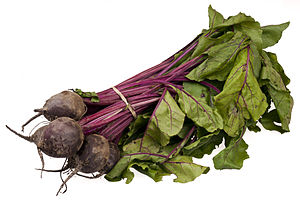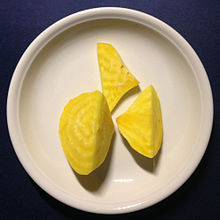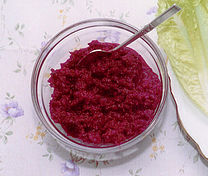Beetroot: Difference between revisions
Grammar Tags: Mobile edit Mobile web edit |
Cyberbot II (talk | contribs) Rescuing 1 sources. #IABot |
||
| Line 142: | Line 142: | ||
* 'Early Wonder', heirloom |
* 'Early Wonder', heirloom |
||
* 'Golden Beet' / 'Burpee's Golden', heirloom (yellow root) |
* 'Golden Beet' / 'Burpee's Golden', heirloom (yellow root) |
||
* 'Perfected Detroit', 1934 [[All-America Selections|AAS]] winner<ref name=aas>{{cite web|title= |
* 'Perfected Detroit', 1934 [[All-America Selections|AAS]] winner<ref name=aas>{{cite web|title=AAS winners 1933 to present |url=http://www.all-americaselections.org/AAS_Winners.asp?Sort1=Year_Won&Sort2=DESC |accessdate=2011-11-04 |deadurl=unfit |archiveurl=https://web.archive.org/web/20100204220637/http://www.all-americaselections.org/AAS_Winners.asp?Sort1=Year_Won&Sort2=DESC |archivedate=February 4, 2010 }}</ref> |
||
* 'Red Ace' Hybrid |
* 'Red Ace' Hybrid |
||
* 'Ruby Queen', 1957 AAS winner<ref name=aas/> |
* 'Ruby Queen', 1957 AAS winner<ref name=aas/> |
||
Revision as of 17:45, 26 May 2016

The beetroot is the taproot portion of the beet plant,[1] usually known in North America as the beet, also table beet, garden beet, red beet, or golden beet. It is one of several of the cultivated varieties of Beta vulgaris grown for their edible taproots and their leaves (called beet greens). These varieties have been classified as B. vulgaris subsp. vulgaris Conditiva Group.[2]
Other than as a food, beets have use as a food colouring and as a medicinal plant. Many beet products are made from other Beta vulgaris varieties, particularly sugar beet.
Uses
Food


The usually deep purple roots of beetroot are eaten either boiled, roasted or raw, either alone or combined with any salad vegetable. A large proportion of the commercial production is processed into boiled and sterilized beets or into pickles. In Eastern Europe, beet soup, such as borscht, is a popular dish. In Indian cuisine, chopped, cooked, spiced beet is a common side dish. Yellow-coloured beetroots are grown on a very small scale for home consumption.[3]
The green, leafy portion of the beet is also edible. It is most commonly served boiled or steamed, in which case it has a taste and texture similar to spinach. Those greens selected should be from bulbs that are unmarked, instead of those with overly limp leaves or wrinkled skins, both of which are signs of dehydration. The domestication of beets can be traced to the emergence of an allele which enables biennial harvesting of leaves and taproot.[4]
Beetroot can be: boiled or steamed, peeled and then eaten warm with or without butter as a delicacy; cooked, pickled, and then eaten cold as a condiment; or peeled, shredded raw, and then eaten as a salad. Pickled beets are a traditional food in many countries.
A traditional Pennsylvania Dutch dish is pickled beet egg. Hard-boiled eggs are refrigerated in the liquid left over from pickling beets and allowed to marinate until the eggs turn a deep pink-red colour.
In Poland and Ukraine, beet is combined with horseradish to form popular ćwikła, which is traditionally used with cold cuts and sandwiches, but often also added to a meal consisting of meat and potatoes. The same in Serbia where the popular cvekla is used as winter salad, seasoned with salt and vinegar, with meat dishes. As an addition to horseradish it is also used to produce the "red" variety of chrain, a popular condiment in Ashkenazi Jewish, Polish, Russian and Ukrainian cuisine.
Popular in Australian hamburgers, beetroot is combined with fried egg (as well as the usual beef patty and salad) to make an Aussie burger.[5]
When beet juice is used, it is most stable in foods with a low water content, such as frozen novelties and fruit fillings.[6] Betanins, obtained from the roots, are used industrially as red food colourants, e.g. to intensify the colour of tomato paste, sauces, desserts, jams and jellies, ice cream, sweets, and breakfast cereals.[3]
Beetroot can also be used to make wine.[7]
Food shortages in Europe following World War I caused great hardships, including cases of mangelwurzel disease, as relief workers called it. It was symptomatic of eating only beets.[8]
- Beetroot as food
-
Salad of grated beet and apple
-
Finnish rosolli
-
Sliced, pickled beetroot
-
Chrain with beet
-
Beetroot juice drink
Other uses
Betanin, obtained from the roots, is used industrially as red food colorant, to improve the color and flavor of tomato paste, sauces, desserts, jams and jellies, ice cream, sweets, breakfast cereals, etc.[3]
Historical uses
From the Middle Ages, beetroot was used as a treatment for a variety of conditions, especially illnesses relating to digestion and the blood. Bartolomeo Platina recommended taking beetroot with garlic to nullify the effects of "garlic-breath".[9]
Preliminary research
In preliminary research, beetroot juice reduced blood pressure in hypertensive individuals[10] and so may have an effect on mechanisms of cardiovascular disease.[11][12]
Beets contain betaines which may function to reduce the concentration of homocysteine,[13] a homolog of the naturally occurring amino acid cysteine. High circulating levels of homocysteine may be harmful to blood vessels and thus contribute to the development of cardiovascular disease.[14] This hypothesis is controversial as it has not yet been established whether homocysteine itself is harmful or is just an indicator of increased risk for cardiovascular disease.[14][15]
Nutrition
| Nutritional value per 100 g (3.5 oz) | |||||||||||||||||||||||||||||||||||||||||||||
|---|---|---|---|---|---|---|---|---|---|---|---|---|---|---|---|---|---|---|---|---|---|---|---|---|---|---|---|---|---|---|---|---|---|---|---|---|---|---|---|---|---|---|---|---|---|
| Energy | 180 kJ (43 kcal) | ||||||||||||||||||||||||||||||||||||||||||||
9.96 g | |||||||||||||||||||||||||||||||||||||||||||||
| Sugars | 7.96 g | ||||||||||||||||||||||||||||||||||||||||||||
| Dietary fiber | 2.0 g | ||||||||||||||||||||||||||||||||||||||||||||
0.18 g | |||||||||||||||||||||||||||||||||||||||||||||
1.68 g | |||||||||||||||||||||||||||||||||||||||||||||
| |||||||||||||||||||||||||||||||||||||||||||||
| †Percentages estimated using US recommendations for adults,[16] except for potassium, which is estimated based on expert recommendation from the National Academies.[17] | |||||||||||||||||||||||||||||||||||||||||||||
Per 100 gram serving providing 43 calories, beetroot is an excellent source (20% of the Daily Value, DV) of folate and a good source (14% DV) of manganese, with other nutrients in low amounts (see table displayed at right).[18]
Safety
The red colour compound betanin is not broken down in the body, and in higher concentrations may temporarily cause urine and stool to assume a reddish colour; in the case of urine this is called beeturia.[19] This effect may cause distress and concern due to the visual similarity to what appears to be blood in the stool, hematuria (blood in the urine), or hematochezia (blood passing through the anus, usually in or with stool). These deceptive appearances are completely harmless and subside once the betanin is out of the system. In the cases of reddish feces, the bright redness from betanin is in contrast to what occurs with melena (very dark or blackish feces) which often indicates that bleeding is occurring further up the digestive system, and is more likely to be a serious problem.
Nitrosamine formation in beet juice can reliably be prevented by adding ascorbic acid.[20]
Cultivars
Below is a list of several commonly available cultivars of beets. Generally, 55 to 65 days are needed from germination to harvest of the root. All cultivars can be harvested earlier for use as greens. Unless otherwise noted, the root colours are shades of red and dark red with different degrees of zoning noticeable in slices.

See also
References
- ^ "beet". def. 1 and 2. also "beet-root". Oxford English Dictionary Second Edition on CD-ROM (v. 4.0) © Oxford University Press 2009
- ^ "Sorting Beta names". Multilingual Multiscript Plant Name Database. The University of Melbourne. Archived from the original on 2013-04-15. Retrieved 2013-04-15.
- ^ a b c Grubben, G.J.H. & Denton, O.A. (2004) Plant Resources of Tropical Africa 2. Vegetables. PROTA Foundation, Wageningen; Backhuys, Leiden; CTA, Wageningen.
- ^ Pin, Pierre A.; Zhang, Wenying; Vogt, Sebastian H.; Dally, Nadine; Büttner, Bianca; Schulze-Buxloh, Gretel; Jelly, Noémie S.; Chia, Tansy Y. P.; Mutasa-Göttgens, Effie S. (2012-06-19). "The Role of a Pseudo-Response Regulator Gene in Life Cycle Adaptation and Domestication of Beet". Current Biology. 22 (12): 1095–1101. doi:10.1016/j.cub.2012.04.007. ISSN 0960-9822. PMID 22608508.
- ^ "Aussie burgers with the lot". BBC Worldwide. 2014. Retrieved 7 March 2016.
- ^ Francis, F.J. (1999). Colorants. Egan Press. ISBN 1-891127-00-4.
- ^ Making Wild Wines & Meads; Pattie Vargas & Rich Gulling; page 73
- ^ MacMillan, Margaret Olwen (2002) [2001]. "We are the League of the People". Paris 1919: Six Months That Changed the World (1st U.S. ed.). New York: Random House. p. 60. ISBN 0375508260. LCCN 2002023707.
Relief workers invented names for things they had never seen before, such as the mangelwurzel disease, which afflicted those who lived solely on beets.
- ^ Platina De Honesta Voluptate et Valetudine, 3.14
- ^ Lundberg, J.O.; Carlström, M.; Larsen, F.J.; Weitzberg, E. (2011). "Roles of dietary inorganic nitrate in cardiovascular health and disease". Cardiovasc Res. 89 (3): 525–32. doi:10.1093/cvr/cvq325. PMID 20937740.
- ^ Hobbs, D. A.; Kaffa, N.; George, T. W.; Methven, L.; Lovegrove, J. A. (2012). "Blood pressure-lowering effects of beetroot juice and novel beetroot-enriched bread products in normotensive male subjects". British Journal of Nutrition. 108 (11): 2066–2074. doi:10.1017/S0007114512000190. PMID 22414688.
- ^ Siervo, M.; Lara, J.; Ogbonmwan, I.; Mathers, J. C. (2013). "Inorganic Nitrate and Beetroot Juice Supplementation Reduces Blood Pressure in Adults: A Systematic Review and Meta-Analysis". Journal of Nutrition. 143 (6): 818–826. doi:10.3945/jn.112.170233. PMID 23596162.
- ^ Pajares, M. A.; Pérez-Sala, D (2006). "Betaine homocysteine S-methyltransferase: Just a regulator of homocysteine metabolism?". Cellular and Molecular Life Sciences. 63 (23): 2792–803. doi:10.1007/s00018-006-6249-6. PMID 17086380.
- ^ a b A.D.A.M., Inc., ed. (2002). Betaine. University of Maryland Medical Center.
- ^ Potter, K.; Hankey, G. J.; Green, D. J.; Eikelboom, J. W.; Arnolda, L. F. (2008). "Homocysteine or Renal Impairment: Which is the Real Cardiovascular Risk Factor?". Arteriosclerosis, Thrombosis, and Vascular Biology. 28 (6): 1158. doi:10.1161/ATVBAHA.108.162743.
- ^ United States Food and Drug Administration (2024). "Daily Value on the Nutrition and Supplement Facts Labels". FDA. Archived from the original on 2024-03-27. Retrieved 2024-03-28.
- ^ National Academies of Sciences, Engineering, and Medicine; Health and Medicine Division; Food and Nutrition Board; Committee to Review the Dietary Reference Intakes for Sodium and Potassium (2019). Oria, Maria; Harrison, Meghan; Stallings, Virginia A. (eds.). Dietary Reference Intakes for Sodium and Potassium. The National Academies Collection: Reports funded by National Institutes of Health. Washington, DC: National Academies Press (US). ISBN 978-0-309-48834-1. PMID 30844154. Archived from the original on 2024-05-09. Retrieved 2024-06-21.
- ^ "Nutrition Facts for Beets, Raw per 100 g". 2012. Retrieved 29 July 2013.
- ^ Frank, T; Stintzing, F. C.; Carle, R; Bitsch, I; Quaas, D; Strass, G; Bitsch, R; Netzel, M (2005). "Urinary pharmacokinetics of betalains following consumption of red beet juice in healthy humans". Pharmacological Research. 52 (4): 290–7. doi:10.1016/j.phrs.2005.04.005. PMID 15964200.
- ^ Kolb E, Haug M, Janzowski C, Vetter A, Eisenbrand G (1997). "Potential nitrosamine formation and its prevention during biological denitrification of red beet juice". Food and Chemical Toxicology. 35 (2): 219–24. doi:10.1016/s0278-6915(96)00099-3. PMID 9146735. Retrieved 2015-06-06.
- ^ a b "AAS winners 1933 to present". Archived from the original on February 4, 2010. Retrieved 2011-11-04.
{{cite web}}: Unknown parameter|deadurl=ignored (|url-status=suggested) (help)
External links
![]() Media related to Beetroot at Wikimedia Commons
Media related to Beetroot at Wikimedia Commons






